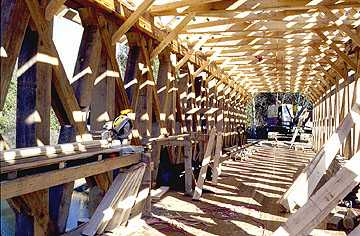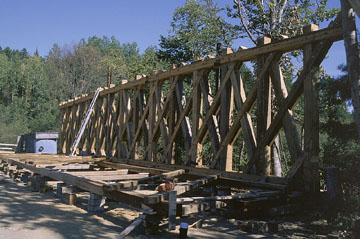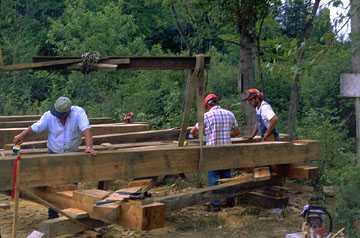Irasburg
Back to Chronicles To Irasburg's Black River Bridge Irasburg's Covered Bridge Lost to Arson The Paddleford Truss Some Notes About the Original Bridge Some Dimensions of the New Bridge Meet The Bridge Man - David GuayIrasburg's New Covered Bridge Opens to Traffic
The Irasburg Covered Bridge is open at last, connecting the towns of Irasburg and Coventry
over the Black River. Governor Dean cut the ribbon in the early evening, Monday, November 29.
The first person to officially cross the bridge was Roy Ingalls, long time Irasburg Selectman. He
drove his pickup truck the final several feet out of the bridge through the south portal with
Governor Dean as passenger.

All of Vermont's covered bridges are unique and each has a quirk of its own -- this one is no exception. John Weaver of the VAOT and the replica's designer pointed out that the original Irasburg Bridge was constructed with a fourteen-panel truss, the number of counties in the state of Vermont. Vermont, of course, was the fourteenth state to enter the union. The replica also uses a fourteen-panel truss.
The new bridge was built by Blow and Cote of Morrisville to replace the Orne covered bridge lost to arson on Halloween, November 1, 1997. The same firm reconstructed the Henry Bridge in North Bennington, and the Gates Farm Bridge in Cambridge. Dave Sargent of the Vermont Agency of Transportation is the construction engineer.

See "Some Dimensions of the New Bridge" below(* Thank you, Jon Armstrong.)
Carpenters Albert Lauzon of Coventry, Roland Blais of Newport, and Louie Fagnant of Arlington cut the laps with chainsaws and cleared the cuts with chisels. The huge timbers were moved into place with the aid of a fork-lift. The prerequisite "camber" was set by bending it into the chords prior to marking out the laps. When the first truss was completed, it was raised by crane into a standing position against a set of steel piles erected for the purpose. When the lifting slings were slacked off, said Fagnant, the truss lost only one-quarter inch of camber.

When the second truss was completed, the two trusses were placed over the river the modern way -- with a crane.
Fagnant noted that he had seen chisels used by an area carpenter bearing the initials J.D.C. - John D. Colton, the builder of the bridge being replaced, and probably the builder of the Paddleford bridge off Old Dump Road (now Covered Bridge Road). One of the antique chisels being used in the bridge restoration carries the initials "W.A.B."
Some Notes on the Dimensions of the Original Bridge

Named "Orne Bridge"on the National Register of Historic Places.
Length: 86'; Width (inside clearance): 15 ' 10"; Portal Height: 11' 9";
Capacity: 4.5 Ton.
The Paddleford Truss: king posts - 8x9 (15/truss), braces - 6x8, counter braces -
4x6.
Deck: deck beams - 9x13, deck sheathing - 2x6 nail laminate, running planks - 3x8.
Roofing: metal, green, standing seam, 12 inch gable-end overhang.
Gable construction: 45 inch overhang each end of bridge supported on corbels; vertical
planking, rounded portal and filets from corbel-ends to eaves, trimmed with white-painted wood
molding; sign - "Strictly No Trucks Allowed Per Order of Selectmen."
Siding: vertical planked; north side planking extends to within 8 feet of eaves, south side
planking to within 22 inches of eaves.
Some Notes on the Dimensions of the New Bridge

This information was provided by Jonathan Armstrong, VTrans Structures and Assistant Designer of the new bridge:
Top and bottom chords- (2) 8 ½" x 11" Glulam Southern Yellow Pine 16F-VI
SP/SP;
Vertical posts (kingposts)- 12" x 12" SYP Dense structural grade 65;
Tension diagonals (counter braces)- double 4"x 8" SYP Dense structural grade 65;
Compression Diagonals (braces-10"x10" SYP Dense structural grade 65;
Floor Beams- 8"x14" SYP Dense structural grade 65;
Floor-5" thick Glulam SYP;
Floor Runners- 3" thick oak (to protect floor);
Between the Floor Runners: 1 ½" Poplar (to protect deck from studded snowmobile
tracks).
Just about everything else is Spruce (rafters, roof boards, rafter beams,
ridge pole, 8"x8" crossties, 4 ½"x4 ½" cross ties, 4"x4" knee braces, 3"x6" plank
railing,
3"x10" end diagonals, side nailers and boarding.
All treenails are white oak (mostly 1 ¼" diameter).
The bridge is designed for 20 ton two axle truck (H20-44).
Joe Nelson, P.O Box 267, Jericho, VT 05465-0267, jcnelson@together.net
Text this page Copyright © 1999, Joseph C. Nelson
Drawing this page Copyright ©, 1999, Joseph C. Nelson
Photographs this page Copyright ©, 1999, Joseph C. Nelson
This file revised 10/26/2006